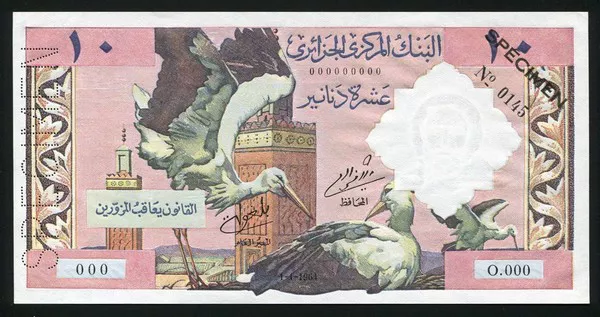Algeria, a country rich in history and culture, reflects its heritage in various aspects, including its currency. The banknotes of Algeria serve not only as a medium of exchange but also as a canvas that portrays the nation’s identity, history, and aspirations. In this exploration, we delve into the intricacies of Algerian banknotes, examining their design, security features, and the stories they tell.
Denominations and Varieties:
Algerian banknotes come in several denominations, ranging from the smaller values used in daily transactions to larger denominations for more substantial financial dealings. The Algerian dinar (DZD) is the official currency, and banknotes are issued by the Central Bank of Algeria.
The current series of Algerian banknotes, introduced in 2018, consists of various denominations: 1000, 500, 200, 100, 50, 20, and 10 dinars. Each denomination features distinct design elements that showcase the country’s cultural and historical significance.
Design Elements:
The design of Algerian banknotes is a meticulous blend of artistry and symbolism. The banknotes showcase prominent figures, historical landmarks, and cultural motifs that resonate with the nation’s identity.
Historical Figures: Algerian banknotes prominently feature notable figures from the country’s history. These individuals are often leaders who played pivotal roles in Algeria’s struggle for independence and subsequent nation-building. Such depictions serve as a reminder of the sacrifices made by those who fought for Algeria’s freedom.
Architectural Marvels: Landmarks and architectural wonders are also prevalent on Algerian banknotes. These images celebrate the country’s rich architectural heritage, featuring structures that hold cultural or historical significance. Such representations offer glimpses into Algeria’s past and its architectural prowess.
Traditional Motifs: Intricate patterns and traditional motifs are woven into the design of banknotes. These elements often draw inspiration from Algeria’s diverse cultural tapestry, incorporating symbols, textiles, or patterns that are emblematic of the nation’s heritage.
Security Features:
Ensuring the integrity of currency is a global priority, and Algerian banknotes incorporate advanced security features to prevent counterfeiting and unauthorized reproduction. These features not only protect the currency but also add a layer of complexity to the banknotes’ visual appeal.
Watermark: A watermark is a common security feature found on Algerian banknotes. Placed discreetly, it becomes visible when the banknote is held up to the light, serving as a quick and effective authenticity check.
Security Thread: A metallic thread with microprinting and color-changing properties is often embedded in the banknotes. This thread is a visible deterrent to counterfeiters and provides an additional layer of security.
Color-Shifting Ink: Certain elements on Algerian banknotes, such as denominations or symbols, may use color-shifting ink. This feature changes color when viewed from different angles, making replication challenging.
Holographic Features: Some denominations may include holographic patches or elements. Holograms are not only visually striking but also difficult to reproduce, adding to the banknotes’ overall security.
Microprinting: Tiny text or patterns that are almost impossible to replicate with standard printing methods are integrated into the design. Microprinting serves as a subtle yet effective anti-counterfeiting measure.
Cultural Representation:
Beyond their utilitarian purpose, Algerian banknotes serve as a canvas for cultural expression. The design elements chosen for these banknotes aim to represent Algeria’s diverse cultural and historical narrative.
Geographical Diversity: Images on banknotes often depict diverse landscapes, from coastal regions to mountainous terrain. This geographical diversity reflects the vastness and variety present within the country.
Celebration of Arts: Algerian banknotes celebrate artistic expressions, featuring traditional music instruments, paintings, or sculptures. This not only honors the nation’s artists but also serves as a testament to the vitality of Algerian culture.
Floral and Faunal Imagery: Some banknotes showcase the rich biodiversity of Algeria, featuring images of native flora and fauna. These depictions underscore the importance of environmental conservation and ecological awareness.
Collectibility and Numismatics:
The aesthetic appeal, historical significance, and security features make Algerian banknotes desirable collectibles for numismatists worldwide. Collectors are drawn not only to the tangible beauty of the banknotes but also to the stories they tell about Algeria’s past and present.
Numismatists often seek pristine, uncirculated banknotes for their collections, valuing the intricate details and vibrant colors that may fade over time with regular circulation. Additionally, collectors may focus on specific denominations or series that hold particular historical or cultural importance.
Online platforms, auctions, and specialized numismatic events provide avenues for collectors to buy, sell, and trade Algerian banknotes. The rarity of certain editions or denominations further adds to their appeal within the numismatic community.
In Conclusion:
Algerian banknotes, with their meticulous design, security features, and cultural representation, serve as both a medium of exchange and a canvas that narrates Algeria’s story. From the leaders of independence to the architectural wonders and traditional motifs, each element contributes to the richness of the nation’s identity. As these banknotes circulate through the hands of individuals worldwide, they carry not only the economic value of the dinar but also the cultural wealth and historical significance of Algeria.


